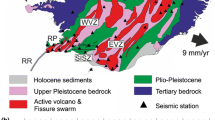Abstract
The different operating requirements of the International Seismological Centre (ISC) from those of the National Earthquake Information Service of the US Geological Survey(NEIS), and of the prototype International Data Center to monitor the Comprehensive Test Ban Treaty (pIDC), result in some discrepancies between earthquake locations computed by the three agencies. For larger events recorded by many stations the differences are small, but for some smaller events differences in location of up to 20° may occur. The largest discrepancies are found for small events in areas where later analysis by ISC has the benefit of additional readings from regional seismograph networks and where ISC has made a different interpretation of the station readingsavailable to pIDC and NEIS. We identify regions where such discrepancies occur most frequently, and give some examples for which the augmented data set of ISC has resulted in significant improvement for specific earthquakes. NEIS and, particularly, pIDC produce their results more speedily than ISC, and these form a valuable starting point for the later, more complete ISC analysis, which is commonly considered the most definitive compilation of global earthquake information.
Similar content being viewed by others
References
Adams, R.D., Hughes, A.A. and McGregor, D.M., 1982, Analysis procedures at the International Seismological Centre, Phys. Earth & Planet. Inter. 30, 85–93.
Bratt, S.R., 1992, GSETT-2: an experiment in rapid exchange and interpretation of seismic data, EOS 73, 513–520.
Jeffreys, H. and Bullen, K.E., 1948, Seismological Tables, British Association for the Advancement of Science, London.
Kennett, B.L.N. and Engdahl, E.R., 1991, Travel times for global earthquake location and phase identification, Geophys. J. Int. 105, 429–465.
Koch, K. and Kradolfer, U., 1997, Investigation of Azimuth Residuals Observed at Stations of the GSETT-3 Alpha Network, Bul. Seism. Soc. Am. 87, 1576–1597.
Author information
Authors and Affiliations
Rights and permissions
About this article
Cite this article
Storchak, D., Bird, A. & Adams, R. Discrepancies in earthquake location between ISC and other agencies. Journal of Seismology 4, 321–331 (2000). https://doi.org/10.1023/A:1009815401999
Issue Date:
DOI: https://doi.org/10.1023/A:1009815401999




